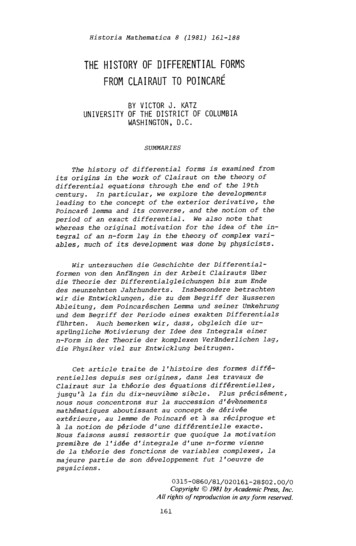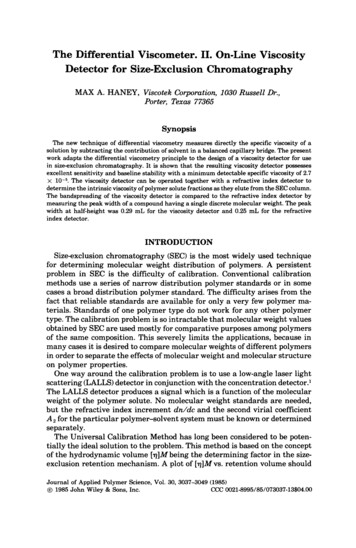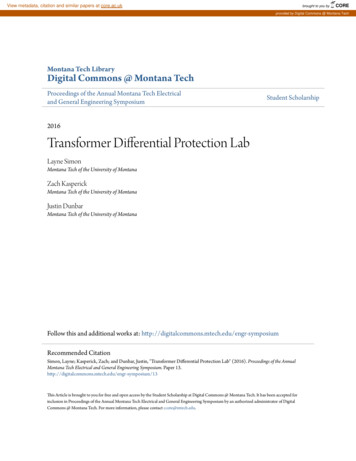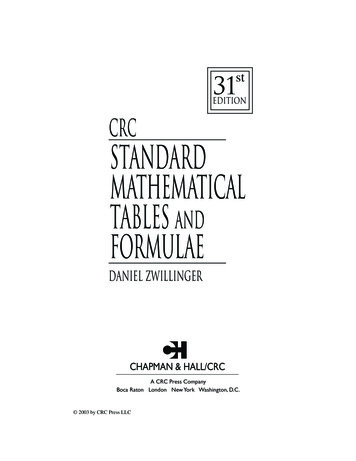
Transcription
HistoriaMathematics8 (1981)161-188THE HISTORY OF DIFFERENTIAL FORMSFROMCLAIRAUT TO POINCARiUNIVERSITYBY VICTOR J. KATZOF THE DISTRICT OF COLUMBIAWASHINGTON, D.C.SUMMARIESThe historyof differentialforms is examined fromits originsin the work of Clairauton the theoryofdifferentialequationsthroughthe end of the 19thcentury.In particular,we explorethe developmentsleadingto the conceptof the exteriorderivative,thePoincarglemma and its converse,and the notionof theperiodof an exact differential.We also note thatwhereasthe originalmotivationfor the idea of the integralof an n-formlay in the theoryof complex variables,much of its developmentwas done by physicists.Wir untersuchendie Geschichteder Differentialformen von den Anf;ingenin der ArbeitClairautsiiberdie Theorie der Differentialgleichungenbis zum Endedes neunzehntenJahrhunderts.Insbesonderebetrachtenwir die Entwicklungen,die zu dem Begriffder B'usserenAbleitung,dem Poincar&schenLemma und seinerVmkehrungund dem Begriffder Periodeeines exaktenDifferentialsfiihrten.Auch bemerken wir,dass, obgleichdie urspriinglicheMotivierungder Idee des Integralseinern-Form in der Theorieder komplexenVerZnderlichenlag,die Physikervie1 zur Entwicklungbeitrugen.Cet articletraitede l'histoiredes formes diff&rentiellesdepuis ses origines,dans les travauxdeClairautsur la theoriedes equationsdiffgrentielles,jusqu'ala fin du dix-neuviemesiecle.Plus pr&cis&ment,nous nous concentronssur la successiond'evsnementsmathgmatiquesaboutissantau conceptde d&rivgeext&ieure,au letntne de PoincarQet a sa r&iproqueeta la notionde perioded'une diffgrentielleexacte.Nous faisonsaussiressortirque quoique la motivationpremierede l'id&ed'integraled'une n-formeviennede la thboriedes fonctionsde variablescomplexes,lamajeure partiede son d&eloppementfut l'oeuvredepsysiciens.O B-0B60/81/020161-28 02.00/oCopyright @ 1981by AcademicPress,Inc.A II rights of reproductionin anyform reserved.161
162VictorJ. KatzHM8INTRODUCTIONDifferentialas "thingswhichof the formformsoccurw Zfare defined(loosely)under integralsigns,"cicx1 2.@kdxa1dxaydxby Flanders[1963]i.e.,expressionsa/where the summation is taken over all k-tuples( 1, "2, . . . . uk)with 15 c%I 12 ** uk 5 n, and the f’s are functionsinn-space.It is the purpose of this articleto discuss the origins of this concept and its development up to the end of the19th century.We will trace the development of the idea of theexteriorderivative,the Poincark lemma and its converse, andthe notion of the period of an exact differential,seeing thatthe motivationfor the concepts of, first,integralsof oneforms and, later,integralsof n-forms lay in the theory of complex variables.Further,we will see that throughout much ofthe 19th century the subjects of line and surface integralswerenot part of pure mathematics at all,but lay in the domain ofphysics.After consideringone-forms and line integralsand, then,two-forms and surface integrals,we will look at generalizationsof the ideas developed in the two special cases.lONE-FORMSThe simplest differentialform and the firstto be considered(in the mid-18th century)is the one-form in two variables,i.e.,Adx Bdy, where A and B are functionsin two-space.For the18th-centurymathematicians,the equation Adx Bdy 0 was simplyanother way of writingthe differentialequation dy/dx -A/B.They were thus interestedin the conditionsunder which a function f(x,y)exists such that af/ax A and af/ay B.If sucha functionexists,then f(x,y) c is a solutionto the equationAdxf Bdy 0.The firstmathematician to consider this form in detailwasAlexis Claude Clairaut.In two papers [1739, 17401 he provedthat the necessary and sufficientconditionthat Adx Bdy bethe differentialof a functionis that dA/dy dB/dx.(This isClairaut'snotation;our current partialderivativenotationdates from the 1840s.)Clairautnoted that the idea had occurredat about the same time to Alexis Fontaine (who never seems tohave published it) and to Leonhard Euler.
HM8DifferentialForms163Clairautproved the necessity of the conditionby an explicitcalculation.To Clairauta functionof two variableswas a(possiblyinfinite)series of terms axmyn bxpyq cxryS *a.Hence he simply calculatedthe differentialof axmy” to bemaxm-lyndx nayn-lxmdyand then noted that the derivativeofmaxm-lynwith respect to y equals that of naynS1xmwith respectto x.The result follows by a form of induction.More interesting for its later use, however, is his sufficiencyproof.Assuming that dA/dy dB/dx,Clairautasserted that the desired functionwas JAdx p(y),where by the firstterm he meantany functionwhose derivativewith respect to x is A, and by thesecond, some functionof y alone.To show that this was correcthe took its differential:Adx dy.r(dA/dy)dx dp.Since dA/dy dB/dxand / (dB/dx) dx is B q(y) , the differentialbecomesSo if p(y)is chosen to be -jq(y)dy,theAdx Bdy dp qdy.expression becomes Adx Bdy, as desired.In other words,Clairautreduced the originaltwo-variableproblem to an ordinary one-variabledifferentialequation,which he assumed to besolvable.One may note furtherthat since q(y) /(dB/dx)dx- B, jBdythe desired functioncan be writtenas jAdxIdy[!(dB/dx)dx]. In fact, Cauchy in [1823] replaced the indefinite integralsby definiteintegralstaken from a fixed point(x0, yg) to a varying endpoint (x,y) and wrote the solutionasf(x,y) sx A(x,y)dx“0 s’ B(xo,y)dy.Yo(1)The use of the definiteintegralbecame the standard textbookmethod for this proof.Clairaut,in his paper of 1740, extended his result to oneforms in three variables.Just as in the two-variablecase, asolutionof Mdx Ndy Pdz 0 was to be a functionf of threevariableswhose differentialwas the given form.Clairautshowed that this was possible if and only if dM/dy dN/dx,dM/dz dP/dx,and dN/dz dP/dy.His proof was similar to theone given for the two-variablecase.Indeed, the necessityproof required only a reductionto that case, while the sufficiency proof started with f IMdx and used the results andmethods of the two-variablecase to show that the differentialof JMdx differedfrom Mdx Ndy Pdz only by a complete differentialin y and z.Finally,Clairautstated the resultfor any number of variMdx Ndy Pdz Qdu Rds ** is integrableif andables:only if any two terms form a complete differentialin those twodM/dy dN/dx,dM/dz dP/dx,and so forth,forvariables;i.e.,every combination of lettersand functions.For future reference we may note that,in modern notation,l
164ClairautVictorJ. KatzHM 8had proved that if u is a one-formin n variables,thenand only if w df, where f is a function.(Strictlyspeaking, of course, this result is not always true for singlevalued functions.In fact, as Jean d'Alembert[1768] observed,the example (xdy - ydx)/(x2 y2) shows that if the coefficientsof the differentialform are not continuous everywhere,the integral may not be single-valued.It took nearly another century,however, for this idea to be exploited.)When 18th-centurymathematicians considered an integralofthe form jAdx Bdy, they meant simply a functionwhose differentialwas Adx Bdy, assuming such a functionexisted;whereastoday, the expression designates a line integral.Although itwas not untilthe early 1850s that jAdx Bdy took on thismodern meaning, the ideas of the line integraland the integralover a curve were being developed long before that time.Thelatterconcept, an integralof the type rfds,firstappeared inthe 18th century.AS early asp76C Lagrange noted that ds (dx2 dy2 dz2) was an element of a curve in three-space.The curve in question represented a wire, and Lagrange was trying to determine its movement if one end is fixed and the restis subject to certainforces.He was thereforeled to considercertainintegralswith respect to ds.Laplace [1799, 691 considered similar integralsof forces acting on bodies along curves.In his MhaniqueanalytiqueLagrange [18111 came somewhatcloser to our modern usage when he considered the rectangularcomponents X, Y, and Z of the forces acting on points of a wire.He noted that the element of wire dm is proportionalto theelement ds of the curve and then considered what he called thesum of the moments of all the forces relativeto the totallengthof the wire, namely, the integral/(X6x Y&y ZGz)dm,whered is a differential"representingonly the infinitelysmallspaces which each point may traversein supposing that the situation of the body varies infinitesimallylittle"[Lagrange1811, 841.this expression can be madeWith a modern interpretation,Theinto a line integral,but Lagrange himself did not do this.use of line integralsin physics became commononly forty yearslater.Thus, despite the work of Lagrange, the chief motivationfor the development of this notion was its use in complex integrals.In 1811 Gauss wrote a letterto Bessel [Gauss 18111 in whichhe discussed the integrationof complex functionsover curvesin the complex plane; but he never published anything substantialIt remained for Cauchy to develop.thisidea.Inin this area.-c Idf(z)dzasahis paper [1825], Cauchy carefullydefinedb ibTo calculatethis integral,he had to describe,analytlimit.ically,a path connecting the two points in the complex plane.He did so by lettingx 4(t) and y (t),c1 t s B, showingi’f(z)(dz/dt)dtmaythat if z x iy, the desired integral,dw 0 if
HM8Differentialbe writtenin theForms165formsBc1 I@’ (t) i ’(t)lf( (t) i (t))dt.If we writef(z) f (x iy) u(x iy) iv(x iy) and dz dx f idy, an easy calculationshows that thisintegralisidenticalto the (complex)line integral/udx - vdy i/udy vdx.AlthoughCauchy did not carryout this calculation,he did demonstrate,by a variationalidea, the "Cauchy integraltheorem,"namely,that if f(z)is bounded and analyticin a region,thenthe integral/ c , id f(z)dzhas the same value no matterwhat(differentiabfef62th is taken from a ib to c id.During the next twentyyears,Cauchy publishedat leastonepaper[Cauchy,18311 in which he performedthe equivalentof aline integralaround a circlein the plane,althoughthe conceptwas not clearlyarticulatedin eithermathematicalor physicalworksof the period[ll.It was not until1846, however,thatCauchy wroteexplicitlyabout integralsover curves,and thenthe curveslay in n-space.In a note in Comptes Rendus [Cauchy,1846a],in fact,the curves,r, over which the integralsare tobe performedare boundariesof surfaces,S, lyingin a space ofany (finite)dimension.One of his resultsstatesthat ifAdx Bdy Cdz .** is an exact differential[2], thenj[A(dx/ds) B(dy/ds) ***Idsdoes not change when !? varies"by insensibledegrees,"so long as the functionsA, B, C, . . .remain finiteand continuousin the entireregionin which thecurve varies.The second major theorem of Cauchy [1846a] assertsthat ifthe functionk A(dx/ds) B(dy/ds) ** failsto be finiteand continuoussolelyat the pointsP', P", . . . in S, and ifcurvessurroundingthese points,respeca, 8, . . . are closedtively,then {kds ,&kds kds l **.In particular,if thereare no such pointsinsideS, thenkds 0.IifiCauchy did not provideproofsof these results,statingonlythat they could be based on formula(1) and its analog with thevariablesinterchanged.Presumablyhe meant that if there wereno singularitiesof A and B withinthe rectanglewhose oppositecornersare (xg,yg)and (x,y),then the functionf(x,y)given by(1) is the same as the functionlg(X,Y)Sinceboth f and g airs
166VictorJ. Katzof sides of the rectangle,the laststatementof theparagraphis true for integralsaround rectangles.of the remainingstatements,even for more variables,difficultto carryout, althoughit is not clear howto make the transitionfrom rectanglesto arbitraryCauchy observedfurtherthat in the two-variable[(dA/dy)- (dB/dx)]dxdy,HM8previousThe proofsare notCauchy meantcurves.case(2)and thereforein the case of an exact differentialthe rightsidevanishes,hence also the leftside.This resultimplies"Cauchy'sintegraltheorem,"of which we have spoken above.It is importantto note that Cauchy never wrote,as we do today, an expressionof the form /Adx Bdy, where the domain ofintegrationis a curve.For Cauchy such an expressioncould onlyhave meant the sum of integralsalong the x axis and y axis,respectively.To integrateover a curve,Cauchy alwaysused thedifferentialelement ds.Hence line integralsin our sense,though implicitin his work,were not explicitlydefinedbyCauchy.In [1846b] Cauchy firstdefinedwhat we now call periodsofintegrals.Observingthat if /kds is taken around a curve whichenclosesan isolatedsingularpoint(k A(dx/ds) B(dy/ds),the integralis increasedby a fixedwith Adx Bdy exact),amount I on each revolution,he calledthis value an index ofIf there are esponding"periods"I, I',I",. . . . then /kds can be writtenas & mI m'I' m"I" 2 -a*, where the m'sare positiveintegersindicatingthe number of times the path of integrationgoesaround the correspondingsingularpoint.It remained,however,for BernhardRiemann to clarifyand toat leastin the two-dimensionalcase.prove Cauchy'sresults,As part of thisprocess,he introducedthe basicideas of whatIn other words,we now callthe topologyof a Riemann surface.insteadof concentratingon the pointsof discontinuityof thecoefficientfunctionsof the differentialform, he focusedhisattentionon the connectednessof the domains over which theyIn 1851, he simplysketchedthisidea in hiswere defined.dissertation,explainingit more fullyin [Riemann 18571.Before discussingthe contentsof [Riemann 18571, it shouldbe mentionedthat in his dissertation,Riemann, likeCauchy before him, wroteonly integralsof functionsover curves,e.g.,and not explicitintegralsof one-forms/(x cos 5 Y cos q)ds,In [Riemann 18571, however,the latterintegrals[Riemann 18511.It was the use of line integralsin physicswhichdo occur.(See, however,the sectionseems to have inspiredthischange.
HM 8DifferentialForms167ClerkMaxwell[1855, 1911 had notedon Ostrogradskiibelow.)that if CL, 8, and y are the rectangularcomponentsof the "intensityof electricaction,"E, and if 1, m, and n are the corresponding directioncosinesof the tangentto the curve,thenE lee f mB ny, and hence I&acan be writtenas lcldx BdyA year laterCharlesDelaunay,in his Treatiseon Rational ydz.Mechanics,discussedthe work done by a force actingalong anamely,if F is a forceand F1 its tangentialcomponent,curve;then the work done along the curve is JFlds;on the other hand,if X, Y, and Z are the componentsof F parallelto the coordinateaxes, then the latterintegralcan be writtenas /Xdx Ydy ZdzVery quicklythereafterthis became[Delaunay1856, 167-1711.standardnotationin physics.Riemann was not concernedwith physicsin his publicationButof 1857, nor did he comment on his own change of notation.Here the nohis mathematicalideas were extremelysignificant.tion of multipleconnectednesswas firstintroduced,and its relRiemannation to the integrationof one-formswas made explicit.began by observingthat the integralof an exact differentialXdx Ydy vanishedwhen taken over the perimeterof a region[3](Thisof the [Riemann]surfaceR which coversthe x-y plane.He continued:followsfrom (2).)Hence the integral/Xdx Ydy has the same value whentaken betweentwo fixedpointsalong two differentpaths.providedthe two pathstogetherform the entireboundaryof a regionof R.Thus, if every closedcurve in theinteriorof R bounds a regionof R, then the integralalwayshas the same value when taken from a fixedinitialpointto one and the same endpoint,and is a continuousfunctionof the positionof the endpointwhichis independentof the path of integration.This givesriseto a distinctionamong surfaces:simplyconnectedones, in which every closedcurve bounds a regionof thesurface. . . and multiplyconnectedones for which thisdoes not happen.([Riemann18571; translationin Birkhoff1973, 52-53)Followingthis,Riemann definedmultipleconnectedness:"A surfaceR is said to be (n l)-plyconnectedwhen n closedindicurvesAl, AZ, . . . . An can be drawn on it which neitherviduallynor in combinationbound a regionof R, whileif augmented by any otherclosedcurve A, l,the set bounds someregionof R" [Birkhoff1973, 531.He also noted that such asurfaceR is changed into an n-plyconnectedsurfaceby any cut(a line going from one boundarypoint,throughthe interior,toanotherboundarypoint)which does not disconnectit, hence intoa simplyconnectedsurfaceR' by n successivecuts which do notdisconnectit.
168VictorJ.KatzHM8Using the idea of cuts,Riemann describedexactlywhat happens when an exact differentialis integratedin an (n I)-plyconnectedregion R.Since the associatedregion R' is simplyconnected,Z(x,y) /Xdx Ydy is a continuousfunctionin R'(where the integrationis performedalong any curve,startingfrom a given point,which remainsin R').However,wheneverthepath of integrationcrossesa cut, the value changes by a fixednumber dependingupon the cut; in fact,there are n independentnumbers,one for each cut.These numbers are, of course,a generalizationof Cauchy'sindicesof periodicity.The notionsof multipleconnectednessand of line integralswere immediatelyexploitedby the physicists.In fact,for thenext thirtyyears line integralsappeared mainly in the domainof physics.Althoughused occasionallyin mathematicsresearchpapers(as we shallsee),line integralscannot be found in anymathematicstextsuntilHermann Laurent'sTraited'analyse[1888].On the other hand, two of the most importantphysicaltextsofthis period,Thomson and Tait'sTreatiseon NaturalPhilosophy(18671 and Maxwell'sTreatiseon Electricityand Magnetism[1873],both containdiscussionsof thisimportantidea.The conceptof multipleconnectednessalso took on importantphysicalmeaning.Hermann HelmholtzextendedRiemann'sdefinitionto three dimensionalregions:An n-plyconnectedspaceis one which can be cut throughbut no more,surfaceswithoutbeing separatedby n-l,into two detachedportions.[Helmholtz1858, 271.In other holtzobservedthat certainimportanttheoremsin potentialtheory--bothin fluiddynamicsand in electromagnetism--failedto hold in a multiplyconnectedregionpreciselybecause integralsof exact differentialscould not then be consideredas singlevalued functions.Helmholtz'importantpaper was translatedintoEnglishin 1868, and immediatelythereafterhis ideas were extended by Thomson and Maxwell.WilliamThomson [1869] fullyexplainedwhat happened whenline integralswere taken in an ingthe theoremsmentionedabove for suchThomson was mainlyinterestedin fluiddynamics,andspaces.his aim was to investigatethe motionsof "a finitemass of n a rigidfixed boundary.The containingvesselmaybe eithersimplyor[Thomson 1868, 133.Thomson illustratedmultiply[connected]"the discussionwith picturesof pretzel-likeregionsand interconnectedrings.He used Helmholtz'definitionof an n-plyconnected space to definenumbers which are similarto Riemann'sLet Fds udx vdy wdz beconstantsand Cauchy'sindices:
HM8DifferentialForms169an exact differentialand 8. be one of Helmholtz'barriersurfaces.Then if pointsP an a Q are "each infinitelynear a pointsurface,"K.is definedtoB Of Bjt but on the two sides of thisbe IFds taken along any curve in the space joinin;P and Q without cuttingany barrier8. Thomson noted that this value is thesame for any such curve and for any point B on Bj [Thomson 1869,43-441.ClerkMaxwell[1873] furthergeneralizedthisidea.He notedthat the line integralaround a closedcurve which passesonlythroughthe jth barrierin a given directionwas Kj.Similarly,if a closedcurve r passesthroughthe jth barrierrn', times,thenthe correspondingline integralwillbeFds mlKlr m2K2 l*. m,K,.Meanwhile,EnricoBetti[1871] had proved a resultmore general than (3).In fact,Bettidiscussedthe connectivityofspaces of n dimensions.Beforeconsideringhis work we mustlook firstat the notionsof two-formsand surfaceintegrals.TWO-FORMSA two-formin three-spaceis an objectof the form Adydz Bdzdx Cdxdy, where A, B, and C are functionsof the threevariablesx, y, and z.They occur under the integralsign inwhat today are edearlyin the 19th centuryin the contextof convertingvolume integralsto integralsoversurfaces.Since the "volume element"is dxdydz and surfacesaretwo dimensional,it seemed naturalto expressthe integralsoversurfacesin terms of productsof pairsof the differentialsdx,dy, and dz.Thus it became necessaryto relatesuch productsto the surfaceelement dS.The motivationfor thisstudy evidentlycame from physics.As in the case of line integrals,we must distinguishbetweenthe two relatedideas of integralsover surfacesand surfaceintegrals.The firstnotionwas alreadyin use, to some extent,in the late 18th century.In the firsteditionof his MkaniqueanalytiqueLagrange[1788] mentionedthe surfaceelement andwas able to writeit explicitlyin the case of a surfacegivenhere dS dxdy(1 p2 q2) , where p af/axby z f(x,y);and q aflay.But it was not untilthe second edition[Lagrange18111 that he introducedthe notionof a generalsurfaceintegral.Here Lagrangenoted that if the tangentplane at the surfaceelement dS makes an angle y with the x-y plane,then by simpletrigonometrydxdy cos y dS.Hence an integralof the form
170VictorJ. KatzHM8is equal to one of the form /A cos y dS, the firstbeingtaken over a region of the plane, the second over the corresponding region of the surface.Similarlyhe noted that if B is theangle the tangent plane makes with the x-z plane and LXthe angleit makes with the y-z plane, then dxdz cos B dS and dydz cos ci dS.Lagrange observed furtherthat the angles a, 8, andy are the same as the angles which a line perpendicularto thesurface elements makes with the x, y, and z axes, respectively.Lagrange had been studying the laws of equilibriumof fluidssurrounding solids;his integralswith respect to dS representthe sum of moments of certainforces applied to points of thesurface of the fluid.He used the transformationsdescribedabove to rewritesuch integralsas true surface integrals,although he did not make precise the exact domain over which thesurface integralshould be calculated.Gauss [1813], on the other hand, was interestedin thegravitationalattractionof an ellipticalspheroid, althoughmathematicallyhe did much the same as Lagrange.However, Gausswas carefulto note that,for example, dxdz tcos f3 dS, wherethe sign is positiveif B is acute, negative if B is obtuse.Inother words, since dxdz is an element of area, it is always positiveand could, of course, be also writtenas dzdx.It was notuntilmuch later that any real meaning was attributedto thechange in order.In any event, Gauss wrote his integralsinthe formfAdxdyI (AcosCY B cos6 C cos(4)y)dSand used such integralsto express volumes in theorems which arespecial cases of what is now called the divergence theorem [Katz19791.than Lagrange in showing howMoreover, Gauss went furtherNamely, for a surto calculatean integralwith respect to dS.face given parametricallyby x x(p,q),y y (p,q),and zargument, that the area Z(P,c?) , he showed, using a geometricalelement dS is equal toa (Y,Z12a (p,q)dpdq[a (z,x12 a0 a(x,Y12a (Prq)1 and hence any integralwith respect to dS can be reduced to anintegralof the form jfdpdq,where f is "eitherexplicitlyorimplicitlya functionof the two variablesp, q” [Gauss 1813, 151.By the 1820s integralsof form (4) began to appear in theworks of other mathematicians.In particular,Ostrogradskii[1826],(refered to in [Yushkevich 1965; Stolze 1978]), Green [1828], andPoisson [1829] all used such integralsin their statements of
HM 8DifferentialForms171But again (as inthe divergencetheorem and relatedtheorems.the analogouscase of line integralsand integralsover curves),explicitintegralsof two forms did not appear,only the corresAn integralof theponding integralsof functionsover surfaces.form IfdS would be relatedto one of the form lgdydz,but thelatterwas always understood to be taken in the y-z plane.Itwas not untilthe 1850s that English physicistsbegan to write,explicitly,integralsof the type /Adydz Bdzdx Cdxdy,whereEven the imthe domain of integrationwas the surface itself.portantsurface integral,JS(amy -aY/as)dyds (ax/a2- az/ax)dzdx (au/ax- ax/ay)dxdy,(5)which recuxred time and again in physical works of the period,firstappeared as an integralwith respect to dS; namely,II [ (az/ay- aY/as) m(ax/as- az/ax) n(aY/ax- ax/ay)ds,where 1, m, and n, are the appropriateequalityof (6) (taken over a surface)s(Xdx/ds Ydy/ds directionwithcosines.(6)TheZdz/ds)ds(taken over the boundary curve of that surface),i.e.,Stokes'appeared in 1854 and was used frequentlytheretheorem, firstafter[Katz, 19791.The expressions in the integrand of (6) are, of course, thevery expressions whose vanishingimplies that a one-form Xdx Ydy Zdz is an exact differenital.Stokes and Thomson, amongothers,studied one-forms for which the expressions do not vansuch expressions represent the components ofish.Physically,the rotationof, for example, a fluid whose velocityvector isThis fact was apparentlyfirstnoticed by Cauchy [X343](X,Y,Z).and Stokes [1845] and was later developed in greater detail.Inparticular,Stokes [1849] considered these expressions in hiswork on diffraction.Since the integrandin (5) is (using modern terminology)theexteriorderivativeof the one-form, Xdx Ydy Zdz, we willfirstconsider the mathematical aspects of its use. AfterJacobi [1836] observed that
172VictorJ. KatzHM 8(an obviousresultof the rulesfor partialdifferentiation),George Stokes[18491 proved what amounts to the converse,that if A, B, and C are functionssatisfyingaA/aXthenA therea.Z/ayexist- functionsaY/azX z aC/az 0,X, Y, and Z suchB Stokes'proof requiredThomson (18511 sketchedwe now present.LetaB/ayax/aznamely,thatc ay/ax- az/ax- axlay.the solutionof Laplace'equation,VU a simplerproof,the detailsof which/(B/3)dz-/(C/3)dy, /(A,‘3)dy-j(B,‘3)dx,Y I(C/3)dx-/(A/3)dz,where the integrationsare all partialwith respectto the givenof integration"isvariable,so that in each case the "constantTo be explicit,let usa functionof the remainingvariables.rewritethese asX f (B/3)dz fl(x,y)-I(C/3)dy f2Y g1 (y,z)-J(A/3)dz g2(x,y) hl(x,z)-JW3)dX hz(y,z).Z/(C/3)dX j(A/3)dy(x,z),rThen,aZ/aY-aY/az A/3 2 13-(1/3)/(aB/ay)dx ahZ/ay-(1/3)/(aC/az)dx- agl/az A k(y,Z)(1/3)i(aA/ax)dX ahZ/ay -agl/aZ.ah2/ay A/3- agl/azf.
HM 8DifferentialForms173It is then simple to choose 91 and h2 such that agl/az- ah2/ay k, thus givingthe desiredresult.(Note that gl and h2 arefunctionsof y and z only.)A similarcalculationworksin thetwo other cases[43.In modern terminologyJacobi'sresultand that of Stokes andThomson togetherprove that if w is a two-formin three variables,Inthen dw 0 if and only if w dn, where n is a one-form.Clairaut'searlier[1740] proof of a simplercase of this result,an importantidea was the reductionof the problem from two variables to one; in Thomson'sproof,the reductionfrom a problem inthree variablesto a problemin two variablesalso played a centralrole.Laterthis resultand proof were furthergeneralized.Thomson needed thisresultin a discussionof solenoidalandlamellardistributionsof magnetism;the firstis a distribution(A, B, C) where ad/ax aB/ay aC/az 0, and the second is onewhere Adx Bdy Cdz is the differentialof some function4.In each case he wanted a formulafor the magneticpotentialV ata point.In the second case, he knew how to find V in terms of9, but in the firstit turnedout that he needed to find thefunctionsX, Y, and 2 in order to obtaina usable expressionforV.Mathematically,a "lamellar"distributionoccurswhen theform w Adx Bdy Cdz satisfiesdw 0; whilea "solenoidal"distributionoccurswhen the form q Adydz Bdzdx Cdxdysatisfiesdrl 0. Nearlyfiftyyears were to pass beforetheunificationof these two ideas under the idea of the exteriorderivativetook place.In any case, by the mid-19thcentury,the basicideas of lineand surfaceintegralswere well understoodand were regularlyused in physicalapplications.In fact,in the preliminarysectionsof [Maxwell18731 there is a detaileddiscussionof mostof the ideas we have considered.THE GENERALIZATIONSOF OSTROGRADSKIIAND BETTIThe work of MikhailOstrogradskiion thissubjectis something of an anomaly.He made a number of importantdiscoveries,but his work appearsto have been totallyignored,at leastinwesternEurope.For example,Ostrogradskiigave the firstcorrect proof of the change-of-variableformulafor double integrals[18381, found the firstgeneralizationof thisformulato anynumber of variables,generalizedthe divergencetheorem to nvariables118361, wrote integralsof n-forms(in our sense)[1836, 18401, and even gave a mathematicaldefinitionof a "region in n-space"[1836].The resultswere reproducedlaterbyother mathematicians,with no creditgiven to Ostrogradskii.This lack of recognitionis difficultto understand,especiallysince Ostrogradskiiwrote most of his papersin French,and the
174VictorJ. KatzHM 8importantwork of 1836 was publishedin the Journalfur dieReine und AngewandteMathematik,one of the most widelyreadjournalsof the day.In particular,Ostrogradskii'sgeneralization[1836] of thedivergencetheorem,with its concomitantintroductionof integralsof n-forms,appeared nowhere else untilEnricoBettirepeatedthem nof the divergencetheorem statesthatstap/ax aR/azaQ/ay l **)dxdydz.V 1 (paL/ax)/[(aL/ax)21 )dyd .(7) 1 (9aL/ay)/[(aL/ay)2i!xdz.f ((RaL/az)/[(aL/az)2] dxdy. l .where L is a functionof the variablesx, y, z, . . . . V is theset of points(x,y,z,.)with L(x,y,z,.) 0; and S is theset of pointswith L(x,y,z,.) 0.(In modern terminology:if there are n coordinates,S is an (n - I)-dimensionalhyperThe integrandsurfaceboundingthe n-dimensionalvolume V.)on the rightin (7) is the firstappearanceof what is calledThe expressionstoday an (n - l)-dimensionaldifferentialform.(aL/ax)/[(aiyaxj2] ,etc.,are simpl
The history of differential forms is examined from its origins in the work of Clairaut on the theory of differential equations through the end of the 19th century. In particular, we explore the developments leading to the concept of the exterior derivative, the P










